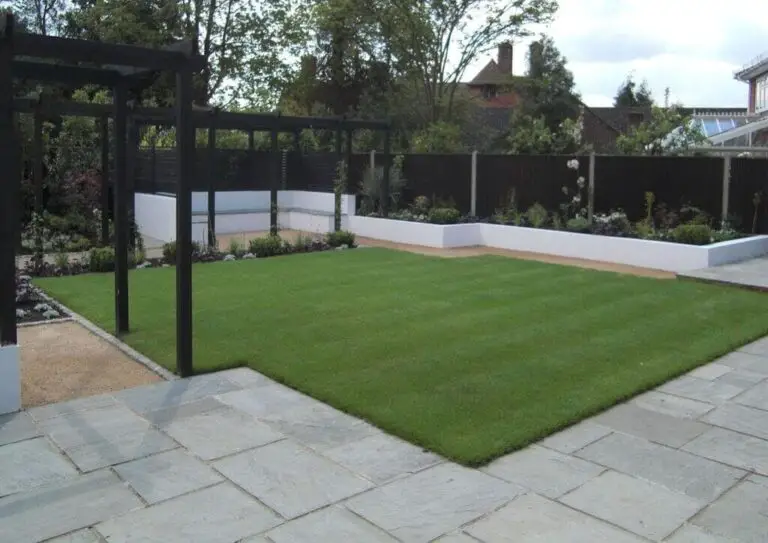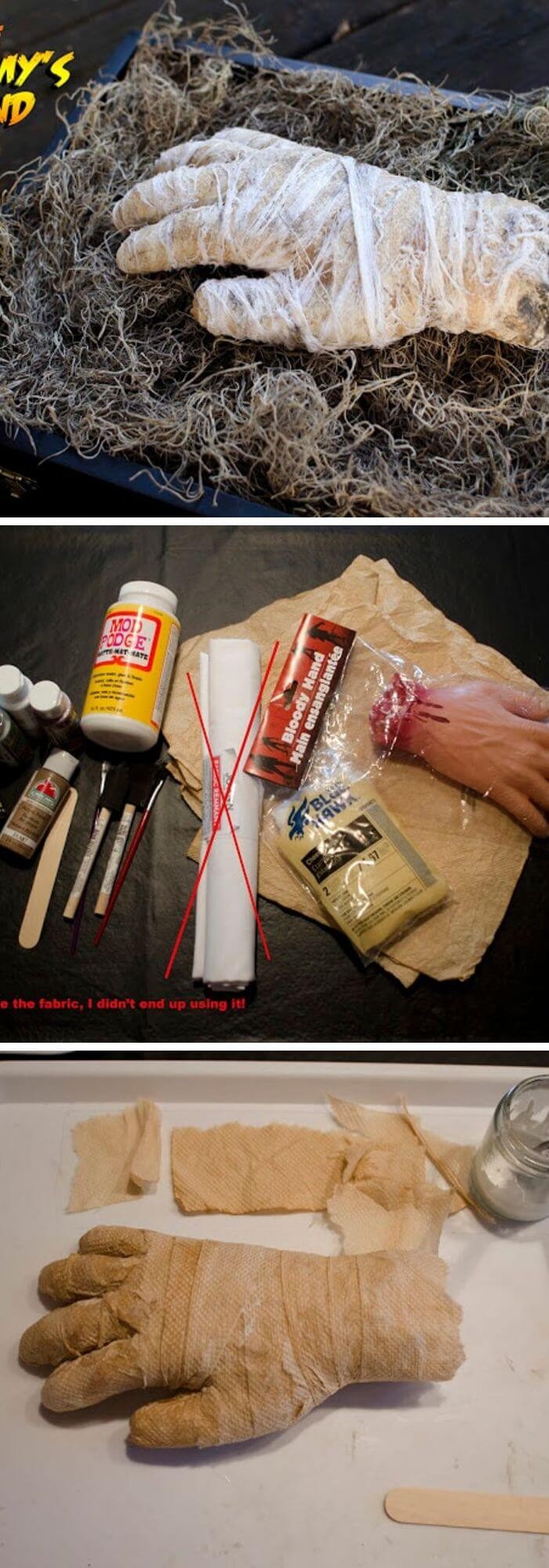Tar And Chip Driveway: Cost, Pros And Cons
Tar and chip driveways are a ubiquitous sight, particularly in rural areas where their cost-effectiveness and durability make them a popular choice. But what exactly is this material, and how does it compare to other options like asphalt? In this article, we’ll delve into the world of tar and chip, exploring its benefits, drawbacks, and installation process. We’ll also provide some inspiration for your own driveway project with 14 unique tar and chip driveway ideas.
Whether you’re a homeowner looking to upgrade your curb appeal or a contractor seeking to expand your services, this comprehensive guide has got you covered. From the initial preparation to the final finish, we’ll walk you through every step of the process. And if you’re wondering about the pros and cons of tar and chip, we’ve got that too – along with some expert tips on how to repair and maintain your new driveway.
What is tar and chip driveway?
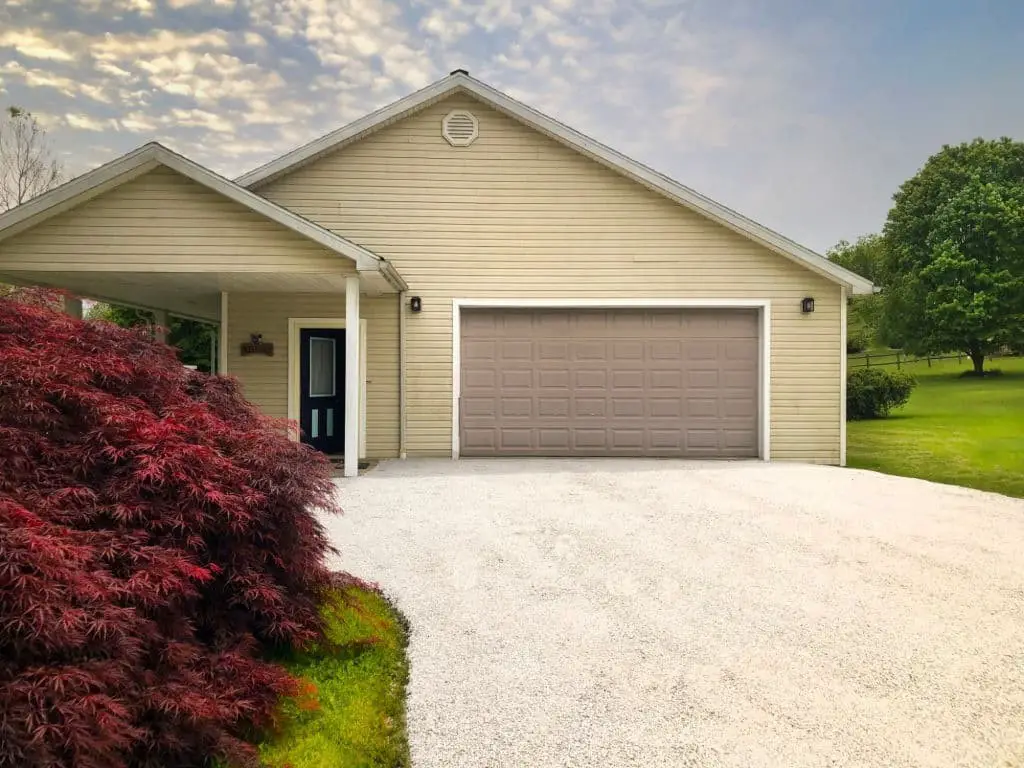
Tar and chip, also known as seal chip, liquid asphalt and stone, or simply Macadam, is a versatile material that has been used for decades in roadwork and driveway construction. Its unique combination of crushed stones and hot liquid asphalt makes it an attractive alternative to traditional asphalt at a lower cost. The process begins with a layer of hot asphalt poured over a gravel base, followed by the addition of loose stones to create a compact and textured surface.
One of the greatest benefits of tar and chip is its customizability – the color and texture of the stone layers can be tailored to suit individual preferences. Furthermore, the compact surface ensures a durable and bump-free driving experience. This material’s versatility has made it a popular choice for many applications.
What does a tar and chip driveway look like?
Initially, tar and chip driveways may seem akin to gravel paths due to their top layer comprising crushed stones. However, a closer examination reveals a distinct difference in appearance, with the dominant hues being tan, beige, gray, and orange – a far cry from the sleek black color of asphalt. It’s likely that you’ve driven on one at some point. The bitumen layer beneath the crushed stones provides exceptional cushioned traction for vehicles.
Tar and chip driveway cost
When considering a tar and chip driveway, it’s essential to note that while it may be slightly more expensive than gravel, it remains a cost-effective option compared to asphalt. In terms of pricing, a tar and chip driveway typically falls within the range of $2-5 per square foot, excluding labor costs and additional materials. This makes it one of the most affordable options among concrete materials.
Moreover, when it comes to repair, maintenance, or replacement needs, tar and chips are often more budget-friendly compared to asphalt and other concrete materials. This affordability factor is a significant advantage that contributes to its popularity over other alternatives.
Tar and chip driveway pros and cons
While tar and chip is a durable and visually appealing option for driveways, it’s essential to acknowledge that it’s not without its drawbacks. To make an informed decision about using this material, let’s weigh the advantages and disadvantages. On one hand, tar and chip offers excellent durability and resistance to weathering, making it a practical choice for areas with heavy rainfall or extreme temperatures. Additionally, it can be easily repaired if damaged, which is a significant plus.
However, its porous nature means it may require more frequent sealing than other options, and the installation process can be labor-intensive and time-consuming.
Pros
While tar and chip may carry a slightly higher price tag than gravel, it’s still significantly more affordable than asphalt and other concrete materials. One of its greatest advantages is its ease of maintenance – unlike some surfaces that require regular sealing, tar and chip can be quickly repaired with crushed stones as small cracks appear, especially during hot seasons when the material tends to heat up and ‘melt’ slightly.
This low-maintenance design also contributes to its impressive durability, lasting up to 12 years without the need for additional layering or sealing. In fact, this cost-efficiency is a major draw for many homeowners. Another key benefit of tar and chip driveways is their excellent traction – similar to asphalt, they provide a smooth, bump-free surface for cars to glide across.
And with its natural earthy tone, achieved through the combination of tar-like substance and crushed stones in various colors, you can enjoy a beautiful, rustic aesthetic that complements your home’s surroundings.
Cons
While tar and chip driveways don’t succumb to heat, they do have one Achilles’ heel – snow plows. In areas where thick layers of snow are a regular occurrence, this material might not be the best choice. If you’re considering a tar and chip driveway in such a location, it’s essential to weigh the pros and cons carefully. On the other hand, if you’re handy with a trowel, mastering the installation process can be a cost-effective way to go about it.
However, be aware that there is a dearth of experienced tar and chip contractors, making DIY installation more challenging than usual. Another consideration is the long-term maintenance of a tar and chip driveway. As the crushed stones break down over time, they can create a messy situation if left unattended. To maintain the integrity of your driveway, it’s recommended to rejuvenate the top layer at least once a year to ensure the stones remain intact.
Tar and chip driveway installation
While tar and chip installation shares some similarities with asphalt concrete installation, there are distinct steps involved. To give you a comprehensive overview of the process, we’ll break down the key stages for your reference. Start by laying down the gravel base according to the desired dimensions of your driveway. Next, melt the liquid asphalt and pour it over the gravel base. At this point, you can choose the color of crushed stones you’d like to use as the topping.
Spread the chosen stones evenly over the liquid asphalt. To complete the surface, apply a thin layer of bitumen and roll it to ensure even coverage. Allow the tar and chip driveway to cure for several days or up to a week before using it. If you’re considering installing your tar and chip driveway DIY-style, there are some essential installation tips to keep in mind. Firstly, it’s crucial to install during warmer seasons when the molten liquid asphalt can dry and cure properly.
The surface should be well-prepared by removing any obstructions – from small leaves to larger structures like basketball rings. Power washing the surface is also necessary to remove any debris or impurities. Additionally, fixing cracks, holes, and dents is vital not only for an even surface but also to ensure a proper bond between the tar and chip. Another important consideration is the cleanliness of the stone chips you’ll be using.
Dirty or dusty chips won’t bind well with the molten liquid asphalt, so it’s essential to clean them first before laying them down. The key to success lies in spreading the chips quickly while the molten liquid asphalt is still hot. This ensures everything remains in place and held together.
Tar and chip driveway vs asphalt
The confusion between tar and chip, and asphalt stems from their shared origin in molten bitumen, a byproduct of petroleum. To gain clarity on their differences and similarities, it’s helpful to consider the following: Both tar and chip and asphalt are durable options, but while tar and chip typically lasts for 7-12 years, asphalt can endure for over three decades. Asphalt also boasts greater load-bearing capacity than tar and chip.
Furthermore, asphalt is available in a wider range of colors and offers a sleek black appearance. In terms of weather resistance, both options provide adequate protection, although asphalt is less susceptible to cracking compared to concrete. Tar and chip, on the other hand, is more prone to cracking. Notably, asphalt is generally more expensive than tar and chip, while still being a more affordable option compared to most concrete materials.
How to repair a chip and tar driveway

Tar and chip driveways are often said to possess a natural self-healing mechanism during the hot summer months. As the surface temperature rises, the finer layers of chipped material tend to soften and fill in minor dents and cracks. However, for added assurance and optimal results, it’s recommended that you inspect and potentially replenish the tar base, followed by an application of new chip material.
If you’re unsure about the best approach, consulting with a professional contractor can provide valuable insights. For further guidance, consider reviewing online tutorials or videos, such as [insert video link], which offer step-by-step instructions for repairing and maintaining chip and tar driveways.
14 Tar and chip driveway ideas
One of the greatest advantages of tar and chip driveways is their adaptability. They can seamlessly blend with various edging materials, such as bricks, stone, or concrete, allowing for a wide range of aesthetic options. Additionally, tar and chip surfaces can serve as the primary material for a rustic, farmhouse-inspired driveway design. To help you get started, here are some innovative tar and chip driveway ideas to consider:
1-2. Tar and chip and pavers driveway
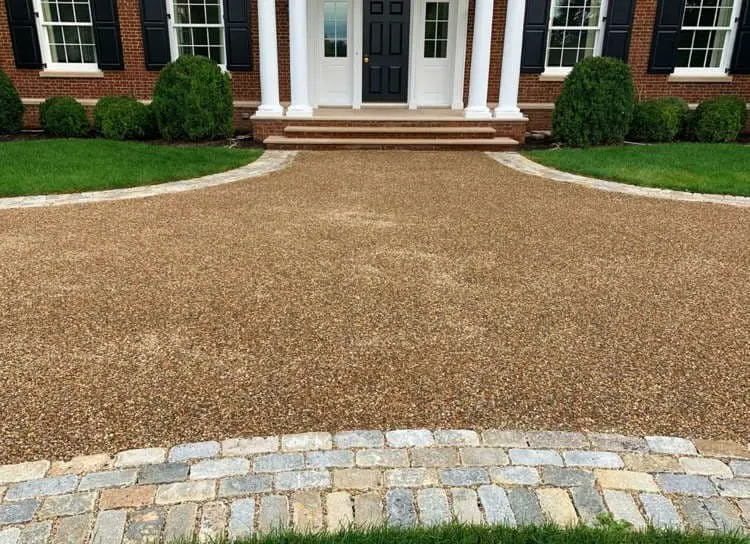
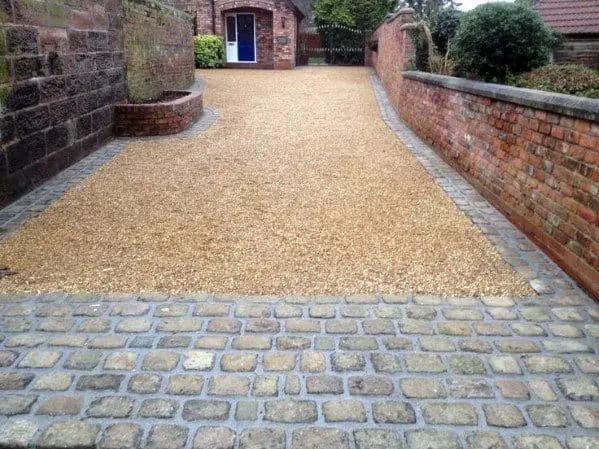
This charming brick colonial-style home boasts a unique blend of textures and colors that creates a striking contrast between its driveway and main residence. The focal point is a sweeping, curved tar and chip driveway, elegantly edged by bricks and pavers to prevent the chips from scattering. The lush greenery surrounding the property beautifully complements the driveway’s rustic charm.
This picturesque courtyard-style driveway features an harmonious combination of stone pavers, bricks, and tan tar and chip, evoking a warm, medieval-inspired ambiance that adds to the home’s timeless appeal.
3-4. Long, tar and chip driveway
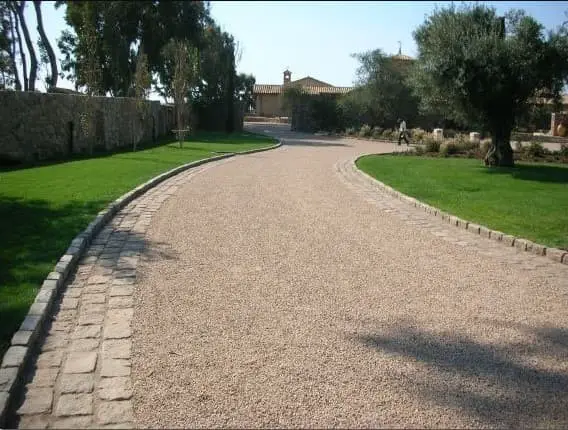
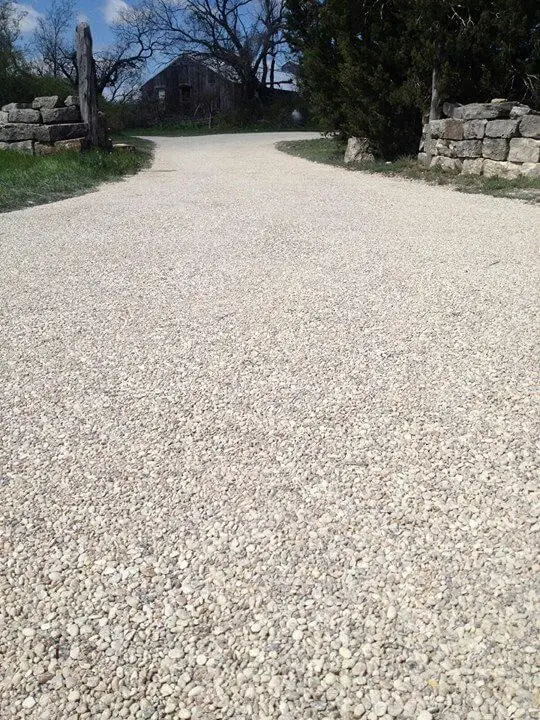
While traditional asphalt is often the go-to material for driveways in rural areas, there’s something to be said about the rustic charm of tar and chip. This material has a unique ability to blend seamlessly into its surroundings, making it an ideal choice for long, winding driveways like this one. The addition of concrete pavers as edging adds a touch of sophistication, elevating the overall aesthetic.
But for those who prefer a more understated look, there’s certainly something to be said about a simple tar and chip driveway with lush grass and shrubbery accents, like this stunning example.
5-8. Stone paver and tar and chip

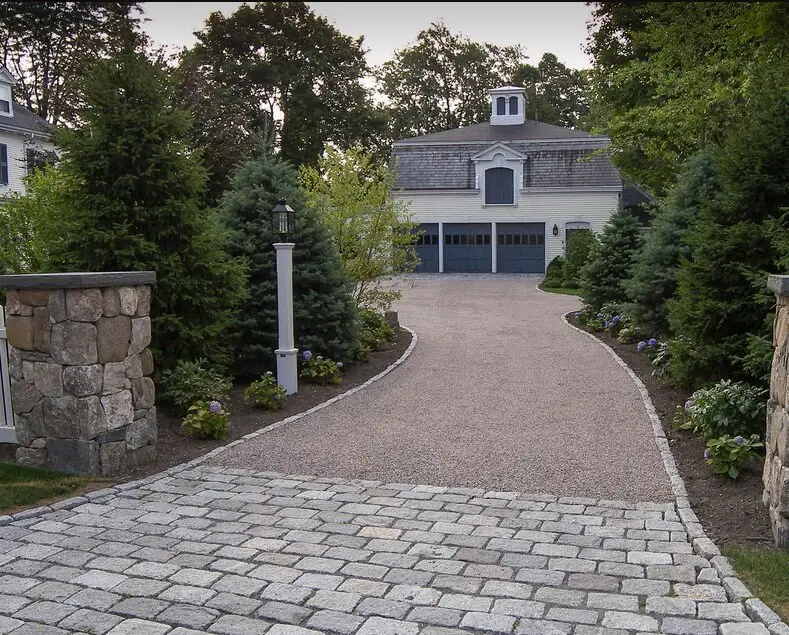
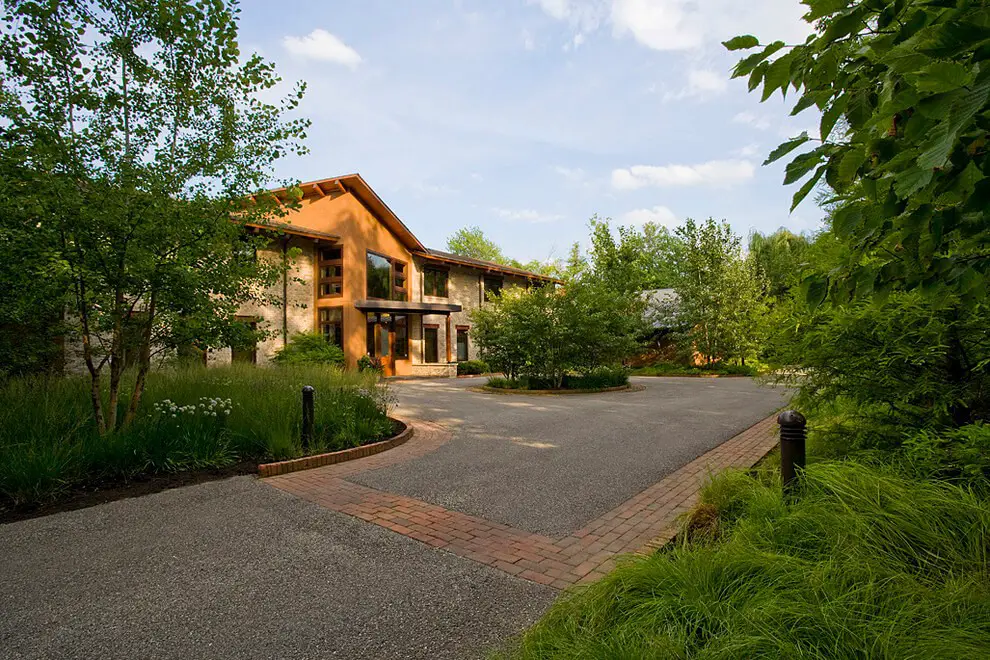

Stone pavers and tar and chip are a timeless combination for driveways. The subtle gray tones of stone pavers can harmonize with any color palette, creating a cohesive look. To add visual interest, consider placing the stone pavers at the entrance of your driveway, flanked by lush grass turfs that create a pleasing contrast. For a seamless aesthetic, you can extend the stone pavers throughout the entire driveway, culminating at your home’s main entrance.
The result is a flowing design that enhances your property’s curb appeal. Alternatively, mix and match stone pavers with tar and chip to create a geometric pattern that injects visual energy into your driveway. This combination of textures and tones can beautifully contrast with the tone of your home. To add an extra layer of sophistication, consider incorporating raised stone boundaries that mimic wooden accents.
This design element can impart a rustic, contemporary vibe to your driveway and yard, creating a unique visual identity.
9-14. Vast, unedged tar and chip driveway
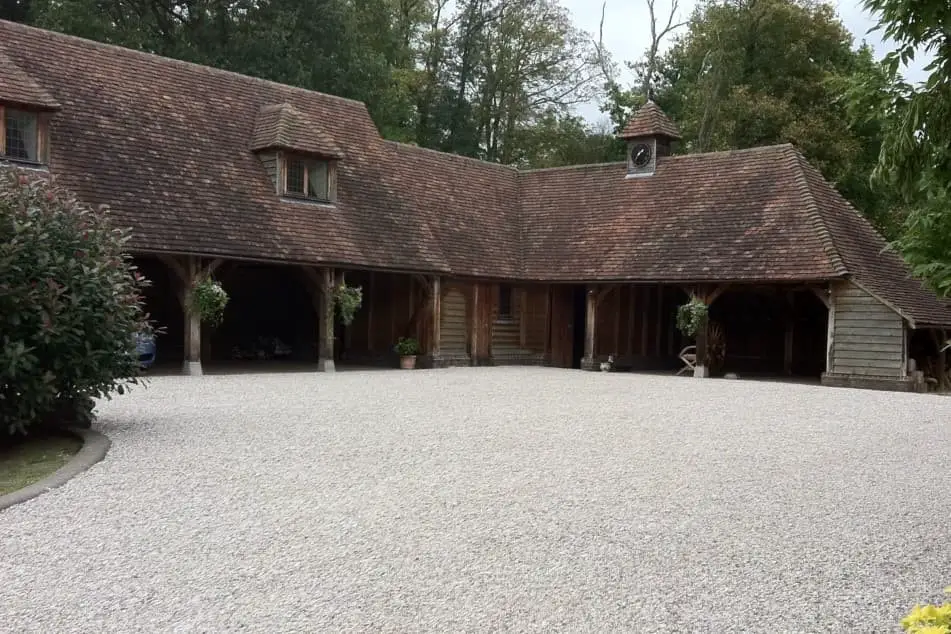
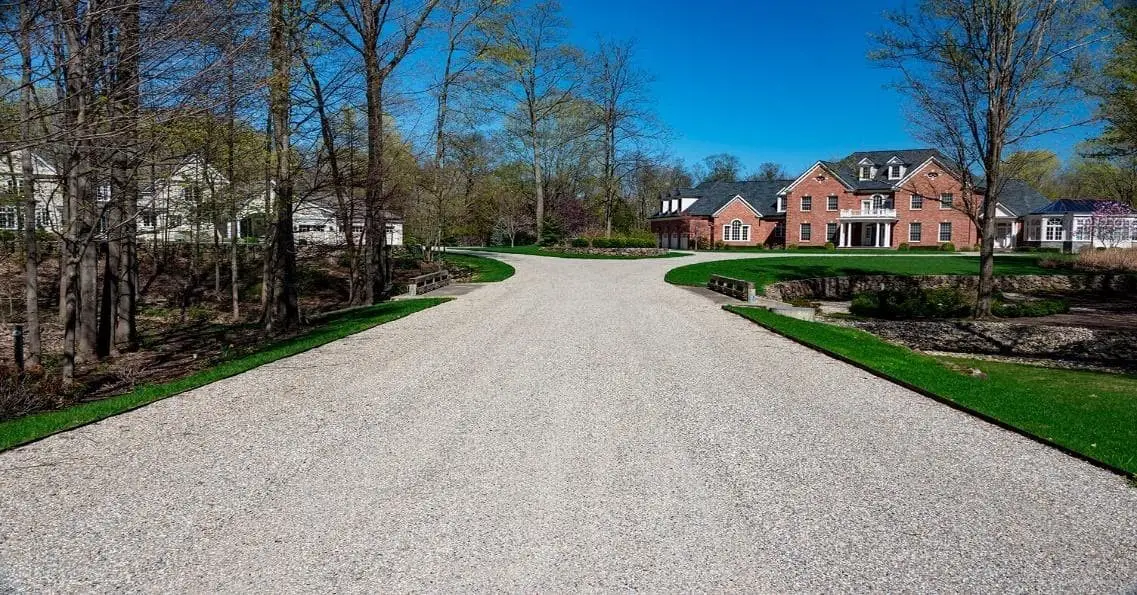


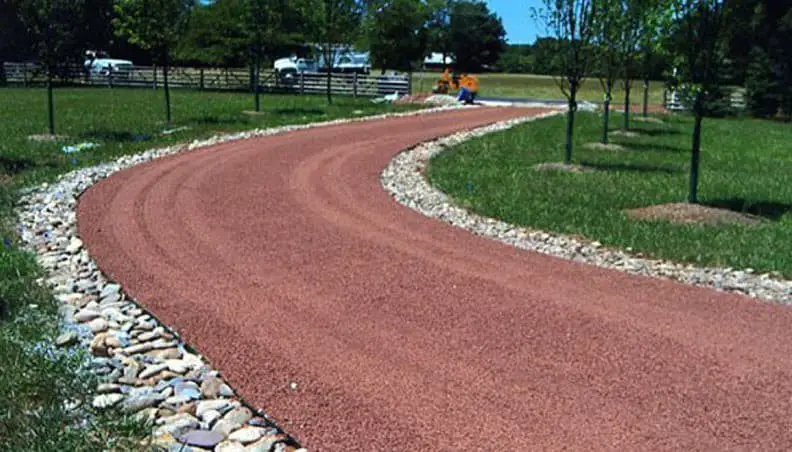
One of the most cost-effective options for a tar and chip driveway is to forego edging materials, allowing the design to focus on emphasizing the expansive nature of the space or a long driveway leading to a large yard. The rustic lodge house in question exemplifies this approach, where a gray-toned tar and chip surface provides a striking contrast to the dark tone of the home, creating a visually appealing aesthetic.
This design is not only budget-friendly but also showcases the ease with which tar and chip can be applied to an entire yard, including the driveway. The minimalist and rustic charm of this design is further enhanced by the addition of colorful stones, which maintains the natural look while adding a touch of personality. Overall, this example demonstrates how tar and chip driveways can seamlessly blend into different home designs.
FAQs
When exploring the world of tar and chip driveways, it’s crucial to consider more than just the basics. To ensure a smooth and successful experience, it’s essential to be aware of additional information. One way to do this is by familiarizing yourself with frequently asked questions (FAQs) related to this driveway material. By staying informed, you’ll be better equipped to make an informed decision if a tar and chip driveway is right for your needs.
How many layers for a chip and tar driveway?
When embarking on a tar and chip installation project, a common misconception is that a single layer will suffice. However, for optimal results, it’s recommended to apply at least two layers of this material. This approach not only enhances traction but also boosts durability, allowing your driveway to withstand the test of time and potentially lasting up to 12 years.
For those looking to refurbish an existing blacktop driveway, a single layer of tar and chip can be a effective solution, providing a fresh and revitalized appearance.
Can you use a pressure washer on a tar and chip driveway?
While asphalt and concrete surfaces can withstand pressure washing, tar and chip driveways require a different approach. In fact, pressure washing is primarily necessary during the preparation phase, where it’s crucial to clear away debris, leaves, and other obstructions before applying liquid asphalt. This ensures a smooth and even application of the material.
How long does a tar and chip driveway last?
Tar and chip driveways typically have a lifespan of around 7 to 12 years, provided they receive proper maintenance. However, as time passes, it’s common for the surface to start showing signs of wear and tear. In order to extend its life cycle, an additional layer of crushed stones and tar needs to be applied. It’s also important to note that even with proper care, concrete driveways can still experience degradation over the years, particularly if they’re subjected to heavy usage.
How long does a tar and chip dry?
After installing the tar and chip coating, it’s essential to allow it sufficient time to dry and cure properly. A minimum of 24-48 hours is recommended for this process. However, even after this initial drying period, it’s crucial not to drive on the surface yet. The ‘tar’ component requires further curing before it reaches its optimal performance. As a result, you should consider the coating fully cured only after at least one week has passed since installation.
This allows the material to reach its full potential and prevents any premature damage or degradation.
How thick should a tar and chip be installed in a driveway?
When it comes to constructing a tar and chip driveway, there’s a general guideline that applies: the aggregate size should ideally fall within the 1.5-inch range. Going below this threshold can result in a less stable surface, while exceeding it may compromise traction. This sweet spot is crucial for ensuring a safe and durable finish.
Can you snowplow tar and chip driveway?
When it comes to maintaining tar and chip driveways, there’s one crucial mistake you should avoid at all costs. Using a snowplow or shovel can inadvertently damage the pavement seal, causing the top layer of chips to break off and potentially wash away in various spots along your driveway or even around your property. A more effective approach would be to allow natural melting processes to occur, thereby preserving the integrity of your tar and chip surface.
Can you dribble a basketball on a chip and tar driveway?
While tar and chip driveways can be a practical choice for many homeowners, they may not be the best option for those who enjoy playing hoops in their backyard. The loose chips on these surfaces have a tendency to stick to the ball, making it difficult to control and maintain a consistent dribble. Furthermore, using the driveway as a makeshift basketball court can also lead to uneven wear and tear on the surface, which may compromise its overall integrity.
For those who plan to use their driveway for casual hooping sessions, a solid surface like blacktop, tarmac, or asphalt might be a more suitable choice, offering a smoother and more consistent playing experience.
Would you need drainage for a tar and chip driveway?
While location plays a significant role, it’s essential to consider the specific characteristics of your area. In the UK, for instance, a tar and chip driveway may still necessitate proper drainage due to the impermeable nature of this surface. This is crucial to prevent water from pooling on the surface. However, in most situations, a well-designed and installed tar and chip driveway can function effectively without supplementary drainage solutions.
Why do they tar and chip roadways?
Tar and chip material serves as a reliable solution for road and pavement preservation. Not only is it cost-effective, but its ability to absorb water makes it an effective deterrent against the softening of roadway bases over time. As a result, tar and chip roads are often chosen as a means of preventing cracks from forming in the long run. This material’s capacity to soak up excess moisture helps maintain the integrity of roadways, making it a popular choice for preservation efforts.
Can you add aggregate concrete to a tar and chip driveway?
Granite and pea shingle are excellent aggregate choices for a tar and chip driveway, providing improved traction and grip on the surface. Angled crushed granite pieces, flat granite, or reflective surfaces all work well in this application. The added bonus of these aggregates is that they protrude above the tar base, ensuring a firm hold even during wet or icy conditions, reducing the risk of slipping.
Can you tar and chip an existing pavement or driveway?
When it comes to asphalt, gravel, or blacktop surfaces, tar and chip can be a viable option for existing pavements or driveways. According to industry experts, this process can significantly enhance the friction level of the surface, effectively adding at least seven years to its lifespan. Moreover, the increased traction reduces the risk of vehicular accidents caused by snow-related conditions.
The ideal time frame for applying tar and chip is during dry and warm seasons, typically spanning from March to August. To further enhance the benefits, it’s recommended to include aggregate concrete in the process.
Is tar and chip still used in main roads?
Tar and chip surfacing has maintained a presence on US and UK main roads, particularly in rural areas, since its inception in the 1930s. While it remains prevalent in outback and rural regions, blacktop and asphalt have largely supplanted tar and chip as the preferred choice for national and primary roadways.
Can you chip seal a tar and chip driveway?
One of the most budget-friendly options for preserving your driveway or pavement is chip sealing, a process that offers numerous benefits without compromising the existing structure. Unlike other methods, chip sealing doesn’t impose any additional weight or pressure on the surface, making it an ideal solution for repairs that don’t require invasive measures.
By addressing surface damage and preventing further deterioration in the long run, chip sealing maintains the integrity of your driveway and pavement. Furthermore, this process provides protection from harsh weather conditions, including extreme heat, which can cause melting and erosion over time. As an added advantage, chip sealing enhances traction by adding friction to the surface, while keeping the chips intact and visually appealing.
This cost-effective solution also boosts curb appeal, making it a practical choice for homeowners seeking to maintain their property’s aesthetic value.
Conclusion
Having covered the key aspects of tar and chip driveways, you now have a solid understanding of what to expect from this popular driveway material. Its durability and cost-effectiveness are likely apparent, making it an attractive option for many. However, it’s crucial to weigh the pros and cons of a tar and chip driveway on a case-by-case basis, considering your unique location and circumstances to determine whether it’s the best fit for you.
Related Posts
When it comes to running a farm business, choosing the right equipment is crucial for efficiency and productivity. Similarly, selecting the perfect garage door color to complement your home’s exterior can significantly impact its curb appeal. However, deciding on the best garage door shade for a green house requires a different approach than pairing with a yellow one.
It’s also important to consider the etiquette of tipping driveway sealers, as it may vary depending on the region and type of service provided. Furthermore, if you’re interested in pursuing a career in landscape architecture, there are certain steps you can take to set yourself up for success.



